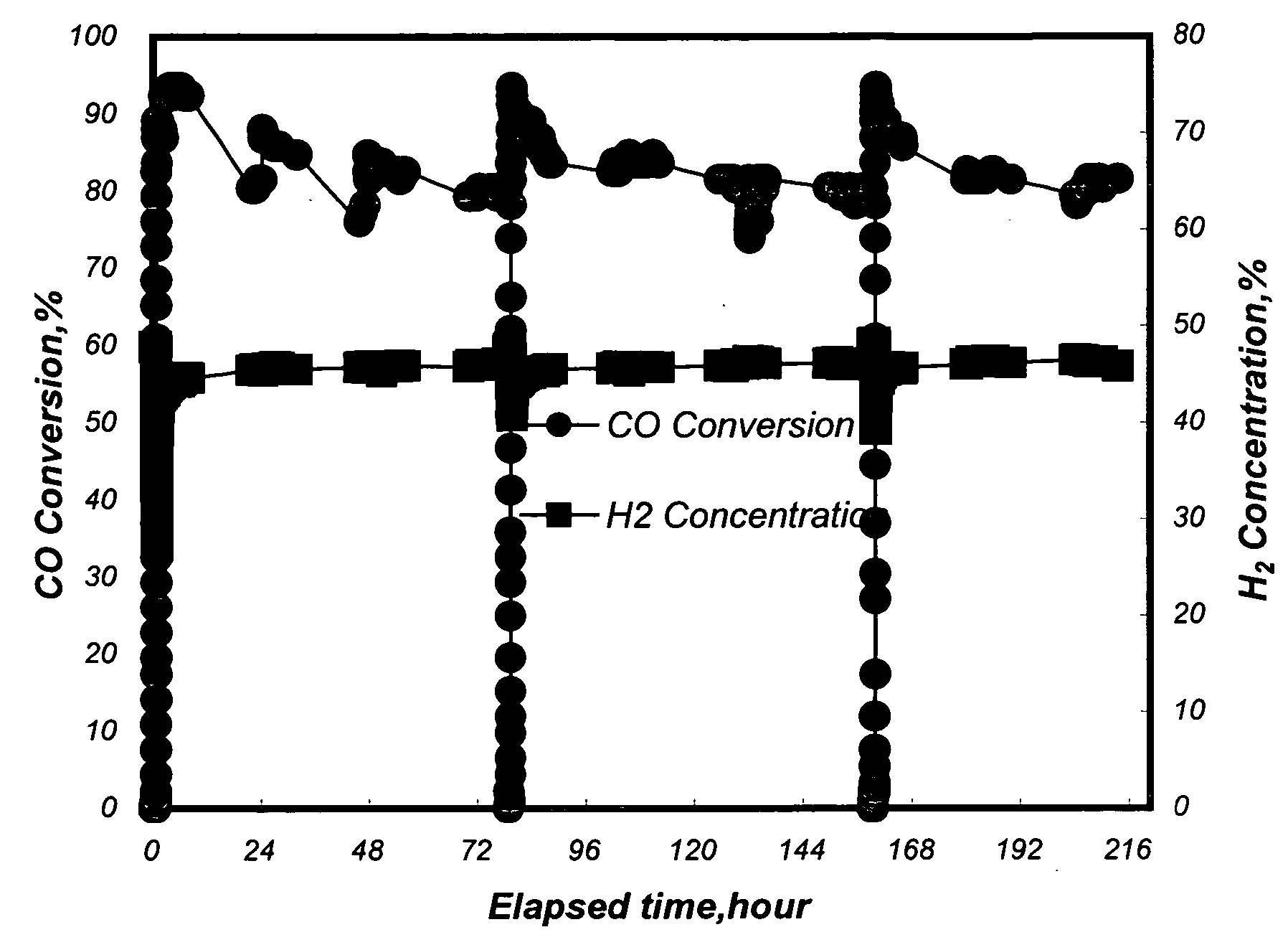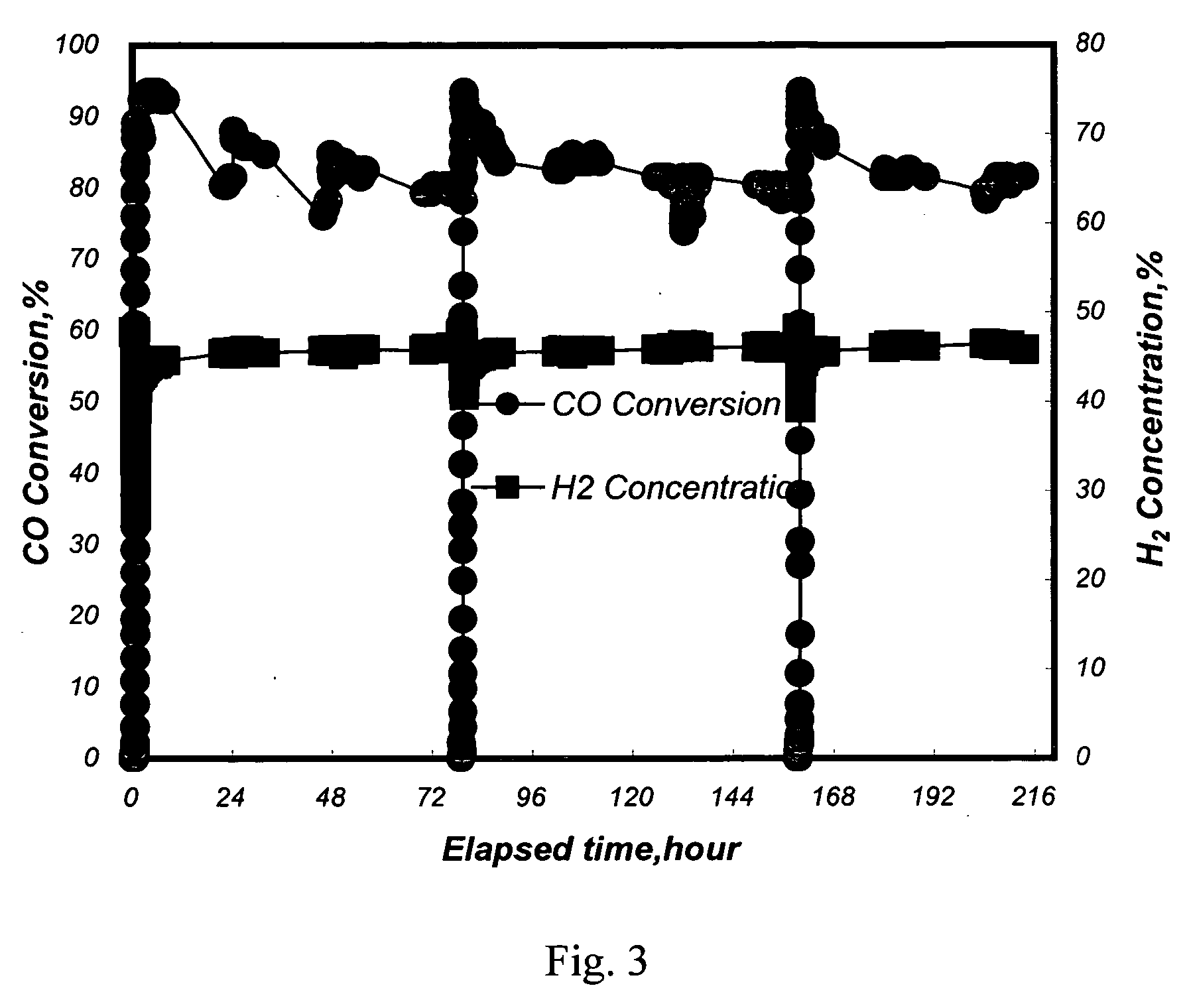Process for the selective methanation of carbonmonoxide (CO) contained in a hydrogen-rich reformate gas
a hydrogen-rich reformate gas and catalyst technology, applied in the direction of physical/chemical process catalysts, separation processes, combustible gas purification/modification, etc., can solve the problems of affecting the lifespan of the catalyst, deteriorating the activity of the catalyst, and high production cost, so as to reduce the loss of hydrogen, the effect of high selectivity and high activity
- Summary
- Abstract
- Description
- Claims
- Application Information
AI Technical Summary
Benefits of technology
Problems solved by technology
Method used
Image
Examples
example 1
[0038] 30 g of Al2O3 granules with a diameter of 3˜5 mm was mixed with an aqueous solution of Ru(NO3)3 (50 g / L, 6.1 ml) containing 0.306 g of Ru, and an aqueous solution of Pt(NO2)2(NH3)2 (50 g / L, 5.9 ml) containing 0.294 g of Pt. The resulting mixture was diluted with deionized water to 110 ml, and adjusted to a pH value of 9˜10 by the addition of sodium hydroxide in order for the Pt and Ru ions to be adsorbed onto the Al2O3 carrier, followed by adding a suitable amount (1.2 g) of hydrazine. The resulting mixture was stirred continuously for 2 hours, followed by filtration to obtain a Pt- and Ru-containing Al2O3 powder. Said Al2O3 carrier containing Pt and Ru was dried (120° C., 4 hours) and calcined (500° C., 2 hours), thereby obtaining a Pt—Ru / Al2O3 catalyst, which contains 0.98 wt % of Pt and 1.02 wt % of Ru, based on the weight of Al2O3, and has an atomic ratio of Pt and Ru of 1:2.
example 2
[0039] The procedures in Example 1 were repeated to prepare a Pt—Ru / Al2O3 catalyst except that the calcining temperature was changed from 500° C. to 900° C., which contains 0.98 wt % of Pt and 1.02 wt % of Ru, based on the weight of Al2O3, and an atomic ratio of Pt and Ru of 1:2.
[0040] A conventional fixed-bed reaction system was used to test the activity and selectivity of the catalysts in a methanation reaction. 12.6 ml of the Pt—Ru / Al2O3 catalysts with a diameter of 3˜5 mm from Example 1 and 2 were separately loaded in a quartz reaction tube with an inside diameter of 2.2 cm. An electric heating furnace was used to control the inlet temperature of a reaction mixture gas to be at 250° C. Said reaction mixture gas contained 50 vol % of H2, 1 vol % of CO, 18 vol % of CO2, 16.5 vol % of H2O, and the balance of nitrogen. The flow rate of the reaction mixture gas was 1000 ml / min (the space velocity, GHSV, being 4700 hour−1).
[0041] The CO conversion ratio (%) is defined as follows:
([...
control example 1
[0045] 30 g of a ZrO2 powder was mixed with a Ru(NO3)3 solution (50 g / L 6.0 ml) containing 0.3 g of ruthenium. The resulting mixture was diluted to 100 ml, and adjusted to a pH value of 9˜10 by the addition of sodium hydroxide in order for Ru to be adsorbed onto the ZrO2 carrier. Next, a suitable amount (1 g) of hydrazine was added, and the resulting mixture was stirred continuously for 2 hours, and then filtered to obtain a Ru-containing ZrO2 powder, which was then dried (120° C., 4 hours) and calcined (500° C., 2 hours), thereby obtaining a Ru / ZrO2 catalyst containing 1 wt % of Ru, based on the weight of the ZrO2 carrier.
[0046] The Ru / ZrO2 catalyst powder so prepared was added with 10 wt % of an alumina sol-gel and water to form a slurry, which was then coated on a ceramic honeycomb carrier with 400 cells / in2, a diameter of 2 cm, and a length of 4 cm, and then dried at 120° C. for 24 hours, and calcined at 500° C. for 2 hours.
PUM
| Property | Measurement | Unit |
|---|---|---|
| Temperature | aaaaa | aaaaa |
| Temperature | aaaaa | aaaaa |
| Temperature | aaaaa | aaaaa |
Abstract
Description
Claims
Application Information
 Login to View More
Login to View More - R&D
- Intellectual Property
- Life Sciences
- Materials
- Tech Scout
- Unparalleled Data Quality
- Higher Quality Content
- 60% Fewer Hallucinations
Browse by: Latest US Patents, China's latest patents, Technical Efficacy Thesaurus, Application Domain, Technology Topic, Popular Technical Reports.
© 2025 PatSnap. All rights reserved.Legal|Privacy policy|Modern Slavery Act Transparency Statement|Sitemap|About US| Contact US: help@patsnap.com



